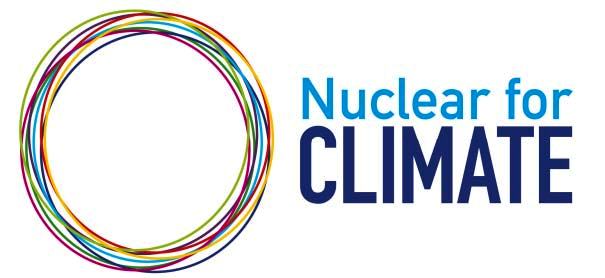
26 Nov Nuclear energy is a key part of the solution to climate change
November 14, 2018
Nuclear energy is a key part of the solution to climate change
Climate change is the most significant threat to our planet today, and yet just three years after the Paris Agreement the world is significantly behind in meeting its climate goals. The latest IPCC report[1] on the impacts of global warming reaching 1.5°C above pre-industrial levels sends a clear warning that this increase may be exceeded by 2030 – 2050.
Nuclear power is recognized as a low-carbon source of energy. According to the IPCC[2], the median lifecycle emissions from nuclear are 12g/kWh, similar to wind energy.
We are convinced that for the benefit of the planet, nuclear must be included in the climate conversation as it is a proven and efficient mitigation technology available today.. Keeping the existing nuclear fleet in operation and adding new capacity can help the world reach its climate goal. Only by combining renewables with nuclear energy, making up a significant part of the world’s future energy mix, can we still deliver on the Paris agreement commitments.
The ability of nuclear energy to reduce greenhouse gas emissions has already been demonstrated.
- Nuclear energy is available today and deployable on a large scale, with over 450[3] reactors in operation across 30 different countries. In 2018, the global nuclear installed capacity reached for the first time 400 GWe, accounting for more than 10% of global electricity production and 30% of global low carbon electricity production.
- Thanks to nuclear, more than 60 Gt[4] of CO2 emissions have been avoided globally since 1970, equivalent to five years’ worth of CO2 emissions from the electricity sector. Nuclear is the second largest source of low-carbon electricity after hydropower.
- The European countries which have achieved a rapid reduction in emissions from electricity production (Sweden, Switzerland, France), are those with a large component of nuclear and hydropower. For instance, France, which produces approximately three quarters of its electricity from nuclear, has the lowest per capita emissions of the seven largest industrialized countries (G7).
- An analysis[5] of the Swedish nuclear program since 1972 has demonstrated the ability of nuclear power to rapidly decarbonise the electricity system: Swedish emissions per capita decreased by 75% in less than 20 years.
The shutting down of nuclear power plants has led to a stagnation of, and even an increase in, greenhouse gas emissions.
Nuclear power plants have been closed in several countries over recent years. Despite the growth of other clean energy sources the result of these premature retirements have been counter-productive for the climate:
- In California, Vermont and New Jersey, when nuclear plants have been prematurely shut down, they have been mostly replaced by power plants fuelled by natural gas from shale.
- In Germany, despite massive investment in renewable energy (25 billion euros per year), the share of coal, its most polluting energy source, has remained stable: the country will not achieve its climate objectives.
- Japan remains the world’s largest buyer of liquefied gas due to the fact that the restarting of nuclear reactors is too slow – its electricity producers are even showing an interest in coal.
International experts have stated that all low-carbon technologies will need to be mobilized in order to stop climate change, including nuclear
- The decarbonisation of the electricity sector is central to tackling climate change: global electricity production ac-counts for 40% of total emissions and is still dominated by coal and gas (63% of total production).
- Decarbonising the electricity sector is a considerable challenge. The latest scenarios set the bar very high, aiming for a total decarbonisation of the electricity system by 2050. At the same time a doubling of electricity consumption is expected due to population growth and the catching-up of emerging countries. Despite massive investments, renewable energies alone are not enough to achieve the decarbonisation required.
- International institutions (UN, OECD-IEA[6], EU[7]) believe that all low carbon technologies (renewable, nuclear and CCS) will need to be implemented in order to achieve deep decarbonisation.
- This is reflected in the latest IPCC1 report. The four 1.5°C illustrative pathways in the Summary for Policymakers include more nuclear, with a two-fold to six-fold increase in nuclear production by 2050.
Increasing nuclear power helps to ensure faster and cheaper decarbonisation
- Nuclear power is available today in all major greenhouse gas emitting regions: China, the United States, India, Europe, Japan … It represents a real low-carbon alternative to coal, since it also ensures large scale 24/7 electricity production.
- The flexibility provided by nuclear power facilitates the development of variable renewable, while limiting reliance on gas. This is already the case today for the French nuclear plants in the Western Europe electricity grid. Future nuclear systems, such as SMRs, are specially designed with advanced load follow capabilities.
- Abundant low-carbon electricity is the preferred tool for achieving deep decarbonisation scenarios. Electrification of different sectors, such as transport, will be facilitated by cheap electricity: a recent study by the MIT[8] shows that the cost of decarbonising electricity is much lower when the mix includes optimal amounts of nuclear.
- The development of future nuclear technologies could enable to decarbonise sectors other than electricity, such as industrial heat production.
“Nuclear for Climate” is an initiative launched by members of the French Nuclear Energy Society (SFEN), the American Nuclear Society (ANS) and the European Nuclear Society (ENS). It now brings together nuclear professionals and scientists from all parts of the globe, through the representation of 150 regional and national nuclear associations and technical societies. The Australian Nuclear Association is pleased to share in this initiative
Information: www.nuclearforclimate.org
Cecile CRAMPON (SFEN) cecile.crampon@sfen.org
Emilia JANISZ (ENS) emilia.janisz@euronuclear.org
Tracy Marc (ANS) tmarc@ans.org
Robert PARKER (ANA) rob.parker@nuclearforclimate.com.au
[1] IPCC special report on the impacts of global warming of 1.5 °C, Octobre 2018
[2] IPCC report 2014
[3] AEA PRIS
[4] IAEA Climate Change and Nuclear Power 2018
[5] China-U.S. cooperation to advance nuclear power, ScienceMag 2016
[6] EA ETP 2017 2DS and B2DS scenarios
[7] EUCO30, Pantelis Capros I3 Modelling Sept 2017
[8] The Future of Nuclear Energy in a Carbon-Constrained World, September 2018



No Comments